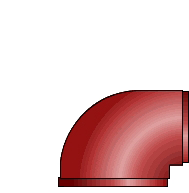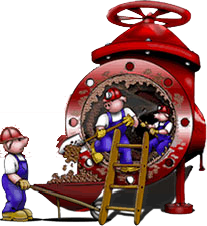One external method for measuring a force mains efficiency is to compare the current volume of flow per kilowatt hour of energy used with previous pumped flow volumes and energy consumption. If five years ago the system was pumping 1,200 gallons per kilowatt hour and now its pumping 800 gallons and the pumps are working properly, its likely the system is getting and will continue to get dirty!!
- During its cleaning the force main system always remains online and always in service.
- Existing connections to the system, i.e., manifolds, headers, clean outs, modifications of inline fittings and designed access ports are used to enter the system. All of the flow and contents of the system are discharged into the normal operating end of the system, i.e., manhole, wet well, other force mains, bar screen, etc. Sometimes special consideration must be given to handling the cleaning load resulting from the cleaning operation
- The only exception to this, is that if it is necessary to create an access port into the system, a brief planned shutdown period may be required or a tapping sleeve and valve may be required.
- The propulsion of the fluids used for the cleaning procedures are provided by the lift station pumps. This factor can eliminate possible concerns about excess pressure threatening the systems integrity. As the system is open to the atmosphere any concerns about hydraulic shock are also minimized.
- The cleaning is carefully planned after the station and systems particulars are extensively reviewed and is done with close coordination with the systems management and operators.
- Supplementary flow may be required to augment the cleaning of a force main. Both to insert the cleaning poly pigs into the system and, as required, for systems that do not develop a discharge volume sufficient for the cleaning process. (Which may account for why they need to be cleaned!)
- As the cleaning process is safely and effectively multidimensional, it can be used to clean a system of varying inline diameters, typically smaller to larger, as well as enter and exit the system at points with different diameters.
- Properly operating inline plug, check or gate valves pose no difficulties for the cleaning procedure.
- There is no restriction on the length of a system that can be cleaned nor one that has severe changes in its profile.
- The cleaning is always done carefully and incrementally, allowing the systems hydraulic capacity to purge itself thereby not putting the operation of the system in jeopardy or at risk.
- A post project report is always provided detailing pre and post cleaning factors about the systems operation including, wet well evacuation times, pump run times, static and operating pressures, inline velocities, flow volume, (GPM), and any operational anomalies noted or discovered during the course of the cleaning procedure.
- The cleaning process is usually designed and applied so that if it is required to be done again sometime in the future it can be done as a matter of routine maintenance.
- Hands on training of system personnel can be incorporated in the project procedures.
Certified Underground Utility Contractor
License Number CU-C057357
License Number CU-C057357



